KOOTENAY
at sea.
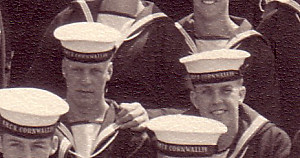
PO2 Ski Partanen (left) in May, 1950 at graduation from HMCS
CORNWALLIS. Photo courtesy of Neil Goodwill.
|
On
the morning of October 23, 1969, HMCS KOOTENAY
was exercising in UK waters with a Canadian Task
Group
consisting of HMC Ships BONAVENTURE,
TERRA
NOVA, FRASER,
ST.
LAURENT, OTTAWA,
ASSINIBOINE,
MARGAREE,
and SAGUENAY.
The Task Group was headed home, westward from the English Channel, and
at 0605 hours when approximately 200 miles off Plymouth, England,
KOOTENAY and SAGUENAY were ordered to separate from the main group and
carry out full power trials.
SAGUENAY completed her trials before 0800 hours and launched her Sea King
helicopter, and KOOTENAY started hers at around 0810 hours. The engine
room received the order for FULL AHEAD - BOTH ENGINES, and the
throttles on both port and starboard turbines were opened up. Both port
and starboard turbines of KOOTENAY's Y100
steam powerplant reached maximum revolutions, in the range of 5,750
RPM, and the main reduction gearboxes transferred power to the
propeller shafts as shaft speed reached 221 RPM (rated maximum shaft
speeds were between 220 RPM (heavy draught) and 227 RPM (light
draught). The ten engineering crew members present in the engine room
were
stationed forward of the control console at the forward end of the
engine room, including the Engineering Officer (EO) and Chief Engine
Room
Artificer (CERA). The engine room crew and their duty stations were as
follows:
Lt. Al Kennedy (EO)
CPO1 Vaino ’Ski’ Partanen (CERA)
CPO2 William Alfred ‘Billy’ Boudreau (Engine Room Chief)
PO1 John MacKinnon (starboard throttle)
PO1 Eric George Harman (port throttle)
LS Pierre “Pete” Bourrett (recording at the console)
LS Thomas Gordon Crabbe (fire and bilge pump)
LS Gary Wayne Hutton (torsion meter readings)
AS Allan "Dinger" Bell (main engine temperature readings)
AS Michael Allen Hardy (main engine temperature readings) |
At 0821, the
temperature in the starboard gearbox reached a critical
level (estimated at 650 degrees C) and the gearbox exploded, sending a
fireball forward in the engine room and up through both engine
room hatches into the main flats (main fore-aft passageway), also named
Burma Road. Smoke immediately filled the ship. Orders were given to
close the throttles and evacuate the engine room. Due to the flames
from the gearbox, the aft hatch was inaccessible, and flames were being
directed towards the forward hatch by the circulation fans. Of
the four
engine room crew who managed to escape via the forward hatch (Kennedy,
MacKinnon, Bourrett, and Bell), one (Bourret) perished right at the top
of the hatch and the rest suffered severe burns. The
remaining six engineering staff all perished in the engine room. The
engineering officer made his way to the bridge, and before collapsing
from his injuries, he reported on
the explosion and stated that the Emergency Shut-offs in the flats
had to be activated immediately to stop the flow of steam to the
still-operating engines.
Two additional crew members also died. OS Nelson Galloway died of smoke
inhalation during the fire, and PO John Stringer died several days
later on BONAVENTURE as a direct result of smoke inhalation.
|
Fire
damage to one of the engine room access hatches in Burma Road.
|
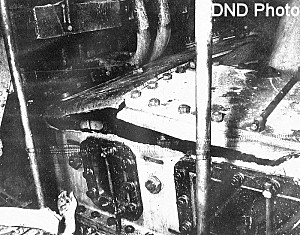
|
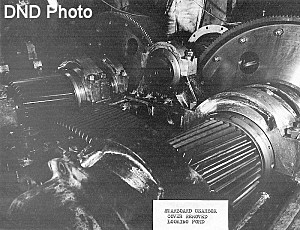 |
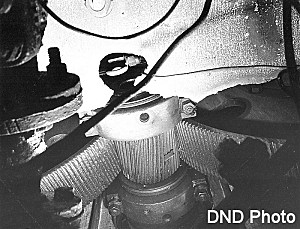 |
The aluminum casing of
the starboard gearbox has been ruptured by the explosion.
|
The starboard gearbox
with the cover removed.
|
The starboard gearbox with the cover
removed. |
A
crew member stands by the blackened control console at the forward end
of the engine room.
|
Despite the
explosion, and the closing of the turbine throttles, both
turbines (now-unmanned) were still receiving steam from the boiler room
and the ship was charging ahead at full speed. In fact, the
steam-driven lube oil circulating pump in the starboard gearbox was
still working, and continued feeding the flames with oil. The
wheelhouse (located below decks on this class of destroyer) filled with
smoke and had to be abandoned, presumably leaving the ship out of
control until
the emergency helm station could be manned. To make matters worse, the
turbo alternator (steam driven electrical power generator, and main
source of ship's power) was knocked out of commission by the explosion,
and the ship's diesel generators were not rigged for auto-start in the
event of power failure. As a result, ship to ship communications were
disrupted during a critical period as available fire fighting equipment
was
running out. Most of the fire fighting equipment, and Chemox breating
apparatus, was stored in the main flats, which was filled with smoke
and flame. |
Looking
forward and to starboard, with the control console to the right of the
photo.
|
The
heat of
the fire was so intense that it melted this engine room ladder, which
made access to the engine room by fire fighting crews more difficult.
|
The forward diesel
generator was started, restoring ship's power, and
at 0836 KOOTENAY was able to broadcast a message stating her emergency
and requesting assistance. SAGUENAY directed her Sea King to KOOTENAY
to assess the situation. This Sea King ended up ferrying equipment,
supplies, and personnel from other ships in the Task Group.
At 0840, the fire was at its height, and the ship was short of
available fire fighting equipment. Seven crew were dead, and numerous
more were incapacitated by burns or smoke inhalation. The fire was
heating up the aft 3"/50 gun ammo magazine, and more crew were tied
up relocating ammunition away from the shared bulkhead. The bulkhead
was sprayed down, but this reduced water pressure and reduced
effectiveness of fire fighting efforts in the engine room. The aft
generator had not yet been started, incapacitating the aft fire pump.
|
At
0900, the boiler room crew were still at their posts shutting down
the boilers and therefore the flow of steam to the engine room. A bulge
was starting to form in the starboard hull plating adjacent to the
gearbox, and visible signs of the fire were visible on the ship's
exterior including smoke from vents and scorch marks on the hull
exterior. The fire gained ground between 0930 and 1000 due to pressure
loss from spraying the magazine, until an engineering rating was
eventually found to start the aft generator thus making the aft fire
pump available for service.
At about 0945, LCDR David Jones arrived by helicopter from BONAVENTURE
to relieve Lt. Kennedy and take over as Engineering Officer.
LCDR Jones reported to the bridge, and in his report he noted the
following:
"a) Major fire in
engine room out of control.
b) Known casualties
in area of fire.
c) Previous E.O.
burned and transferred to BONAVENTURE.
d) Boiler room shut
down.
e) Number 1 and 3
diesels supplying electrical power.
f) "F" section
isolated electrically.
g) Fire fighting
teams had entered the after engine room hatch and gone part way down
the ladder, but intense heat and lack of visibility precluded further
entrance.
h) Lt/Cdr. Schwartz
was taking charge of fire fighting along with Cmd.O Moffat.
i) Ventilation to
engine room stopped.
j) Fire main
pressure low (35 PSI)."
It would not be until 1010 that the fire could be considered under
control. When CPO2 Robert George entered the engine room via the
forward hatch at 1015, the heat was so intense that it was necessary to
keep a low velocity fog on him at all times. The fire was put out
between 1030 and 1100, and after 1100
crews could enter the engine room and remain without being driven back
by the severe heat. KOOTENAY was rigged for tow, and SAGUENAY was
tasked to start the tow which was underway by 1114. The engine room was
cooled down between 1130 and 1215, at which
point the damage assessment and removal of the six bodies from the
engine room began.
|
Damaged
instrument panels in the engine room. |
A valve is pictured in
front of a fire-gutted bulkhead.
|
KOOTENAY was badly
damaged, and only remained afloat due to the efforts
and sacrifices of her crew. Seven of her crew members, present in the
engine room for the full power
trial, had died, and two more crew members died of injuries sustained
outside the engine room. Fifty-three crew members were injured.
The tow was subsequently taken over by the Royal Navy tug SAMSONIA
(formerly Foundation
Josephine) on October 24th and KOOTENAY returned to the UK under
SAGUENAY's continued escort. KOOTENAY was dry-docked and her propellers
were removed to prepare her for the tow to Canada, which was undertaken
by the Dutch tug Elbe on
November 16th. KOOTENAY arrived in Halifax on
November 27th.
|
A
Board of Inquiry was set up immediately following the accident. Captain
Chris Pratt (ret.) was commanding the 5th Squadron at that time, and he
was flown ashore to conduct the Board of Inquiry in Plymouth. He
recalls: "To help me with the inquiry
I had an engineer officer, a medical officer and a damage control
specialist. A civilian designer from NDHQ, who was the one to note the
wrongly installed bearing liner, came to offer his advice. The liners
had been designed to fit either port or starboard gearbox, but care was
needed to install them the correct way round. Apparently it's not
unheard of for a bearing to "wipe" without catastrophic results. That
had probably happened during an earlier full power run, and probably
when I commanded the ship, for I was her skipper from January 1965
until June 1966. But exactly how it happened was only a matter for
speculation, for as you know, fire requires fuel, heat, and oxygen.
There was a vent pipe...from the gearbox. It ran up through the PO's
mess to the upper deck, and witnesses reported a sound like that of a
pipe organ in the PO's mess before the explosion. The theory was that
initially a fire had started using the small amount of oxygen present
in the gearbox. This created an overpressure up throught the vent,
which made the sound, and then had extinguished itself for lack of
oxygen. The pipe cooled, outside air was drawn down into the gearbox,
and it exploded."
It was concluded that the insert bearing shells had been installed
backwards in the starboard gearbox four years previously, which cut off
the proper flow of
lubricating oil, leading to overheating of the bearing and the ignition
of
the lubrication oil. It was also noted that the explosion and fire had
killed and injured a significant portion of the engineering staff, thus
incapacitating a large part of the crew most experienced in damage
control measures. This had a particularly deleterious effect on the
organization and effectiveness of the damage control and fire fighting
crews in the aftermath of the explosion. After the accident, the ship's
captain, CDR Neil Norton, wrote that "...a
less professional crew could
easily have finished the day in life rafts".
Captain Pratt also comments: "The
"PTSD" factor was disturbing, even thought the term didn't come into
use for another twenty years or more. It wasn't wartime, when enemy
damage might be expected, and the event came as a total shock. Of
course we're trained to expect the unexpected, and I was sure that
everyone had behaved correctly, and some had gone far beyond what could
have been expected. But there was certainly no counselling. Vice
Admiral Griffin, the Admiral at Plymouth, offered to find homes in the
neighbourhood, to send everyone on a few days leave, which was done
during the Second War, but the two ships' companies preferred to stick
together, which I could understand. There was such a widespread
syndrome of self-blame, even by those who had done far more than their
duty, which is characteristic behaviour after a shock. I feel
particularly for Sub Lieut Reifenstein, who put on scuba gear to crawl
along the Burma Road. He blamed himself bitterly for not being able to
find the steam shut off valve." Partly as a result of the
incident, Sub Lieutenant Reifenstein later committed suicide.
The accident on KOOTENAY
ultimately influenced the Canadian Navy's training in Damage Control
down to the present day, and in fact the Navy's East Coast Damage
Control training facility is named after KOOTENAY. This remains the
worst peacetime accident ever
experienced by the Canadian Navy.
|
A
fire-blackened instrument panel in the engine room. |
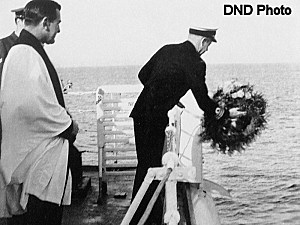 |
CPO1
Vaino ’Ski’ Partanen
CPO2 William Alfred ‘Billy’ Boudreau
PO Eric George Harman
PO Lewis John Stringer
LS Pierre “Pete” Bourrett
LS Thomas Gordon Crabbe
LS Gary Wayne Hutton
OS Michael Allen Hardy
OS Nelson Murray Galloway
With the exception of
PO Stringer, who died in Bonaventure during the return voyage and who
as a result was buried in Canada, these were the last Canadian
servicemen killed overseas whose bodies were not repatriated.
|
| A wreath laying
ceremony at sea. |
|
|
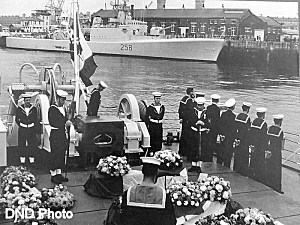 |
|
|
A funeral service,
presumably on the quarterdeck of SAGUENAY in Plymouth.
Note KOOTENAY in the background, with scorch marks on her starboard
side amidships.
|
|
|
Sources:
Barrie, Ron and Macpherson, Ken. (1996). Cadillac of
Destroyers: HMCS ST. LAURENT and Her Successors. Vanwell
Publishing
Ltd. St. Catherines, Ont.
Forbes, Gord. (2007). Article "An Incident on the High Seas" in Soundings Magazine. http://www.noac.ottawa.on.ca/fallsoundings07.pdf
Heimpel, Roger, LCDR. (2007). Article on gearbox explosion. Provided by
author.
Jones, David, LCDR. (1969). Report on explosion. Provided by author.
Kingston,
Gaylord. (2006). Article "Tragedy at Sea" in Crown and Anchor. http://www.acpoa.ca/news/oct2006/oct2006.pdf
McLeod, John, CPO1. (1999) Article "KOOTENAY tragedy remembered 30
years later". Source unknown. Courtesy Neil Goodwill.
Pratt, Chris, Captain (ret.). (2009) E-mail correspondence.
RCN Publication. (1968). Machinery
Digest for Destroyer Escorts, 205, 206, 257 and Classes. Queen's
Printer and Controller of Stationary, Ottawa.
Unattributed timeline of events by speakers CDRs Walton and Yanow, date
unknown. http://www.forposterityssake.ca/Kootenay1.htm
Unless noted otherwise, all photos are courtesy of LCDR
Roger Heimpel, CFNES Damage Control Division.
|



